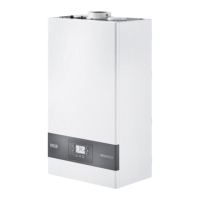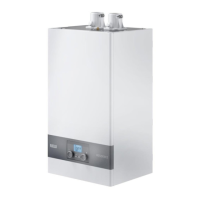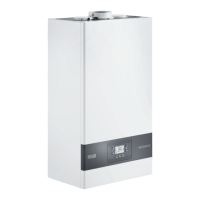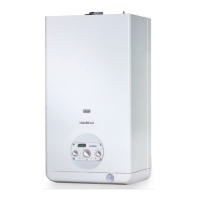41
COMMISSIONING
3 COMMISSIONING
3.1 Preparing for initial startup
9
NOTICE: Risk of boiler damage through contaminated com-
bustion air.
− Never operate the boiler in very dusty conditions, e.g. if
building work is taking place in the installation room.
− Ensure adequate ventilation.
− Never use or store chlorinated cleaning agents or haloge-
nated hydrocarbons (as contained in spray cans, solvents
or cleaning agents, paints and adhesives, for example) in
the boiler room.
− A burner contaminated during building work must be
cleaned before commissioning.
− All cover plates, enclosures, clean out ports, and guards
must be in place at all times, except during maintenance
and servicing.
− Never burn garbage or paper in the unit, and never leave
combustible materials around it.
3.2 Third party control units
Control panels are not supplied.
9
NOTICE: System damage due to incorrect sensor position!
Safety cut-out and thermostat sensors of third party control units
must be tted in the instrument tapping of the heating
supply of the boiler.
− The third party control unit (building management system
or PLC controllers) must ensure a maximum internal boil-
er water temperature that is sufciently different from the
high limit safety cut-out. It must also be ensured that the
digital burner controller rather than the boiler water tem-
perature regulator switch the burner on and off.
− The control unit must ensure that the burner is switched to
low load before being shut down.
− Select control equipment that allows a gentle start-up with
a time delay when the system is cold.
− After the burner demand, an automatic timer (for example)
should limit the burner to low load for a period of approx.
180 seconds. This restricted heat demand will prevent un-
controlled starting and stopping of the burner.
− It must be possible to show the number of burner starts on
the control unit used.
3.3 Hydraulic connection to the heating system
− If the system temperatures are different, use both return
connectors high temperature and low temperature. For an
optimum energy yield, we recommend supplying a ow
rate of > 10 % of the total nominal ow rate via the low
temperature ange, with a return temperature below the
dew point. If there are no varying return temperatures,
only the low temperature ange needs to be connected.
− Size the pumps correctly. High ow rates and oversized
pumps can result in the accumulation of sludge or deposits
on the heat exchanger surfaces.
− Before connecting the boiler, ush sludge and dirt out of
the heating system.
− Ensure that no oxygen enters the heating water during op-
eration.
− Only operate the boiler in sealed unvented systems.
3.4 Making the electrical connection
9
DANGER: Danger to life through electric shock!
− Before opening the boiler, isolate the heating system across
all life phases and secure against unintentional reconnec-
tion.
− Carefully route the cables/leads and capillary tubes.
− Ensure that capillaries are never kinked.
− Only carry out electrical work if you are a competent per-
son. If you are not suitably qualied, arrange for a quali-
ed electrician to make the electrical connections.
− Observe local installation regulations.
− Create all electrical connections in accordance with Nation-
al Electrical Code or the applicable and local regulations.
9
NOTICE:
− The phase-neutral polarity has been respected.
− A ground (earth) connection is obligatory.
Wiring diagrams related to the burner installation may be found in
the burner installation manual.
3.5 Fitting temperature sensors
9
NOTICE: System damage through damaged capillaries or in-
correctly tted temperature sensor.
− Ensure that the capillaries are neither kinked nor squashed
when uncoiling and routing them.
− Always push the temperature sensor right to the bottom of
the sensor well.
− Insert the temperature sensor set as far as it will go into
the test point (to the bottom). Use the mark to check
whether the temperature sensors are correctly tted.
− Secure the temperature sensor set in the test point with a
sensor retainer.
− Never kink excess lengths of capillaries.
− Route the sensor lead through the cable conduit to the
control unit.
− Connect the sensor lead to the control unit.
− Complete the commissioning report.
